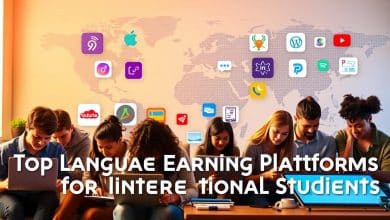Online Learning Trends Shaping Education in 2025
The educational landscape continues shifting as technology reshapes how knowledge is delivered. Traditional classroom models now compete with dynamic digital platforms designed for today’s workforce. Organizations increasingly prioritize adaptable training methods that align with rapidly evolving professional demands.
Skill gaps grow wider as industries adopt new technologies faster than ever. Static training programs struggle to address these changes, creating urgency for responsive elearning solutions. Businesses now demand measurable outcomes from every dollar invested in employee development.
Modern learners expect personalized experiences that match their unique needs. Multigenerational teams further complicate this balance, requiring platforms to cater to diverse preferences. The focus has shifted from standardized courses to interactive formats that boost engagement and retention.
This article explores how innovation drives progress in digital education. From AI-driven tools to hybrid delivery systems, we’ll analyze strategies preparing professionals for tomorrow’s challenges. Discover how forward-thinking institutions bridge gaps between current practices and future skills requirements.
Emerging Technologies Transforming eLearning
Cutting-edge innovations are redefining how expertise is cultivated in modern education systems. These advancements create adaptive environments where technologies respond to individual progress, making skill development more efficient than traditional methods.
Artificial Intelligence and Intelligent Tutoring Systems
AI analyzes learner behavior to build customized pathways. Over 60% of educators report improved engagement through systems that adjust content based on performance gaps. Intelligent tutors mimic human instructors, offering instant feedback during complex tasks.
Administrative automation frees instructors to focus on creative teaching strategies. Automated grading and attendance tracking streamline operations across platforms, ensuring consistency in large-scale programs.
Virtual and Augmented Reality Immersions
VR transports users to simulated labs or historical sites, making abstract concepts tangible. Medical trainees practice surgeries in risk-free environments, while engineers test design prototypes through AR overlays.
These tools foster teamwork in virtual spaces. Students collaborate on projects as if sharing physical workstations, merging practical knowledge with interactive problem-solving. This approach bridges theory and real-world application seamlessly.
Online Learning Trends 2025: Adaptive Learning and Personalized Paths
Education systems now prioritize individualized growth through adaptive learning technologies. These solutions reshape professional development by aligning with each learner’s pace, strengths, and goals. Unlike rigid programs, they dynamically evolve to meet shifting demands.
Real-Time Adjustments in Adaptive Systems
Modern platforms analyze performance metrics to modify content instantly. If a user struggles with data analysis concepts, the system offers simplified explanations or practice modules. This responsiveness prevents frustration and maintains momentum.
Engagement patterns trigger adjustments too. Learners who prefer visual content receive more infographics, while auditory learners get podcasts. These tweaks optimize retention without manual instructor intervention.
Customized Experiences Powered by AI
Algorithms map skill gaps across teams, suggesting targeted paths for improvement. A marketing team might receive SEO training alongside crisis communication resources, addressing specific departmental needs.
Continuous feedback loops refine these recommendations. As employees complete microlearning activities, AI updates their development roadmaps. This ensures alignment with both personal aspirations and organizational objectives.
Microlearning, Gamification, and Mobile Learning Innovations
Education strategies now prioritize efficiency through compact formats that fit modern lifestyles. The global microlearning market, valued at $3.4 billion in 2023, is projected to double by 2030 as professionals seek flexible skill-building methods.
Bite-Sized Content Strategies for Engaged Learners
Short modules lasting 2-7 minutes address shrinking attention spans. Research shows 58% of employees prefer these focused segments, which:
- Break complex subjects into manageable steps
- Use videos or infographics to simplify concepts
- Allow practice through quick quizzes
This approach reduces cognitive overload while improving knowledge retention by 17% compared to traditional courses.
Interactive Gamification and Mobile Accessibility
Platforms now integrate game-like features to boost motivation. Common elements include:
- Points for completing challenges
- Badges showing skill mastery
- Leaderboards fostering friendly competition
Mobile optimization ensures 68% of users can access content during commutes or breaks. Responsive designs adjust layouts for any screen size, while touch controls make navigation intuitive.
Data-Driven Insights and Social Learning Engagement
Educational institutions and corporations now harness granular data to refine training methods. By analyzing patterns in engagement and performance, platforms identify opportunities to make learning more responsive to individual needs. This approach transforms raw numbers into actionable strategies for growth.
Analytics and Predictive Learning Models
Advanced systems track over 50 metrics, from quiz scores to time spent on modules. Predictive algorithms flag potential obstacles weeks before they affect learners. For example, a student struggling with calculus might receive targeted practice problems automatically.
These models adapt content delivery based on real-time insights. If 70% of a group misses a key concept, the platform adjusts explanations or suggests peer study sessions. This proactive approach reduces dropout rates by 22% in corporate training programs.
Collaborative Platforms for Peer-to-Peer Learning
Digital workspaces now replicate office whiteboards and breakout rooms. Teams solve case studies together, while AI moderators highlight valuable contributions. One platform saw a 40% increase in completed projects after introducing shared annotation tools.
MIT research confirms that collaboration drives innovation. Groups using knowledge-sharing tools develop solutions 30% faster than isolated peers. Gamified challenges take this further—teams earn rewards for crowdsourcing answers to complex scenarios.
Integrating Trends for a Future-Ready Educational Landscape
Organizations face unprecedented challenges in building training systems that meet diverse needs. The Power of 10 Framework by EI merges ten critical innovations into a unified strategy for sustainable growth. This blueprint helps institutions balance immediate skills development with long-term adaptability.
Blending Innovative Technologies for Holistic Learning
The framework combines AI-curated content with immersive simulations. For example, engineers might troubleshoot virtual machinery while receiving real-time feedback from intelligent tutors. Such integration bridges gaps between theoretical knowledge and workplace demands.
Key components include adaptive microlearning modules and multisensory scenarios. A sales team could practice negotiations through VR role-plays, then review behavioral analytics to refine techniques. These experiences strengthen retention while accommodating different learning preferences.
Implementation requires balancing resources with strategic priorities. Successful adopters often start with skill-gap analyses before deploying meta-learning games or collaborative platforms. Change management proves crucial—72% of organizations report higher success rates when involving stakeholders early.
While blending technologies presents challenges, the payoff includes measurable outcomes like 45% faster onboarding. Continuous feedback loops ensure alignment with evolving goals, creating ecosystems where growth becomes systemic rather than sporadic.
Conclusion
The evolution of workforce development now hinges on embracing trends shaping digital education. Organizations that dismiss these shifts risk falling behind in rapidly evolving industries. Adaptive elearning platforms and AI-driven tools aren’t optional upgrades—they’re survival tools for modern businesses.
Effective strategies merge immersive simulations with personalized experiences to boost engagement. Teams gain practical skills through scenarios mirroring real-world challenges. Data analytics refine these approaches, ensuring training aligns with measurable goals.
Success requires reallocating resources toward agile systems that grow with market demands. Prioritizing learner-centric designs fosters inclusivity while closing competency gaps. The path forward demands experimentation, iteration, and unwavering focus on outcomes.
Corporate training’s future lies in ecosystems where innovation meets practicality. Those who adapt will build resilient teams ready for tomorrow’s unseen challenges.
FAQ
How does adaptive learning improve skill development?
What role does augmented reality play in modern education?
Why is microlearning gaining popularity?
How do predictive analytics shape personalized paths?
Can gamification increase course completion rates?
What makes collaborative platforms effective for peer learning?
How are institutions balancing innovation with accessibility?
Published on: 16 de August de 2025







